Journal of Digital Technologies and Law
Статьи журнала - Journal of Digital Technologies and Law
Все статьи: 206
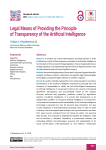
Legal Means of Providing the Principle of Transparency of the Artificial Intelligence
Статья научная
Objective: to analyze the current technological and legal theories in order to define the content of the transparency principle of the artificial intelligence functioning from the viewpoint of legal regulation, choice of applicable means of legal regulation, and establishing objective limits to legal intervention into the technological sphere through regulatory impact. Methods: the methodological basis of the research is the set of general scientific (analysis, synthesis, induction, deduction) and specific legal (historical-legal, formal-legal, comparative-legal) methods of scientific cognition. Results: the author critically analyzed the norms and proposals for normative formalization of the artificial intelligence transparency principle from the viewpoint of impossibility to obtain the full technological transparency of artificial intelligence. It is proposed to discuss the variants of managing algorithmic transparency and accountability based on the analysis of social, technical and regulatory problems created by algorithmic systems of artificial intelligence. It is proved that transparency is an indispensible condition to recognize artificial intelligence as trustworthy. It is proved that transparency and explainability of the artificial intelligence technology is essential not only for personal data protection, but also in other situations of automated data processing, when, in order to make a decision, the technological data lacking in the input information are taken from open sources, including those not having the status of a personal data storage. It is proposed to legislatively stipulate the obligatory audit and to introduce a standard, stipulating a compromise between the technology abilities and advantages, accuracy and explainability of its result, and the rights of the participants of civil relations. Introduction of certification of the artificial intelligence models, obligatory for application, will solve the issues of liability of the subjects obliged to apply such systems. In the context of professional liability of professional subjects, such as doctors, militants, or corporate executives of a juridical person, it is necessary to restrict the obligatory application of artificial intelligence if sufficient transparency is not provided. Scientific novelty: the interdisciplinary character of the research allowed revealing the impossibility and groundlessness of the requirements to completely disclose the source code or architecture of the artificial intelligence models. The principle of artificial intelligence transparency may be satisfied through elaboration and provision of the right of the data subject and the subject, to whom the decision made as a result of automated data processing is addressed, to reject using automated data processing in decision-making, and the right to object to the decisions made in such a way. Practical significance: is due to the actual absence of sufficient regulation of the principle of transparency of artificial intelligence and results of its functioning, as well as the content and features of the implementation of the right to explanation the right to objection of the decision subject. The most fruitful way to establish trust towards artificial intelligence is to recognize this technology as a part of a complex sociotechnical system, which mediates trust, and to improve the reliability of these systems. The main provisions and conclusions of the research can be used to improve the legal mechanism of providing transparency of the artificial intelligence models applied in state governance and business.
Бесплатно
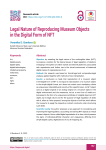
Legal Nature of Reproducing Museum Objects in the Digital Form of NFT
Статья научная
Objective: by revealing the legal nature of the nonfungible token (NFT), to propose a solution for the topical issues of legal regulation of relations emerging in the sphere of online market and Internet platforms, associated with reproduction and further use in the virtual environment of tokenized digital copies of original pieces of art. Methods: the research was based on formal-legal and comparative-legal analysis, applied together with methods of law interpretation. Results: a conclusion is made that reproduction of a museum object in the digital form of NFT is not equal to reproduction of a museum object in the simple digital format, as it does not contain such mandatory criteria as uniqueness, indivisibility and scarcity of the specific token. An NFT object acts as a digital original of an analog original of a museum object in the digital environment and the metaverse, not as a new form of media art. Expressed in the form of a uniqueness certificate of a digital object, an NFT object, by its legal nature and for the purpose of legal regulation of deals with it, refers to “other property” among the objects of civil law, which allows the museums to apply the respective contract constructs when structuring such deals. Scientific novelty: the author proposes a new approach to considering and improving the legal regulation, accounting and storing NFT objects as virtual museum objects, the so-called digital equivalents of an item, which possess the signs of individual-definite character and uniqueness, differing from simple digital copies, digital pieces of art, 3D mapping, etc. Practical significance: the research results can be used for improving legal regulation of museum activity, correcting the civil and museum legislation, in particular, for defining virtual museum objects; for implementation of law, for example, when signing deals on using and selling NFT objects, in terms of specifying the content and volume of authorities of the right holders of the nonfungible token.
Бесплатно
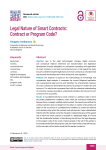
Legal Nature of Smart Contracts: Contract or Program Code?
Статья
Objective: due to the rapid technological changes, digital economy and contractual relations determine law transformation and legislation development towards adaptation to prospective spreading and application of smart contracts in civil and commercial turnover. In this regard, the study focuses on determining the legal essence of smart contracts as a fundamental step towards the development of their timely and clear regulation. Methods: the research is based on the methodology of formal-legal and comparative legal analysis. It compares the current Bulgarian legislation with supranational legal sources and identifies the characteristic features of smart contracts as demanded instruments necessary for modern law and economy. The article also compares them with the classical understanding of contracts, making it possible to understand and define the nature of smart contracts more accurately. Results: it was determined that a smart contract is a software code in which the parties predetermine conditions under which the contractual relationship between them is created, modified and terminated. The research proved that the contract execution does not depend on the action or inaction of its parties, but rather on the occurrence of a predetermined condition (a certain fact relevant to the parties) under which the contract must self-execute. It was substantiated that the will of the parties cannot be changed or replaced because of the special way in which the smart contract is recorded in a distributed ledger. It is found that the fundamental problem of transferring the will from the legal language to the program code of the smart contract persists: if the will of the parties is incorrectly transferred to the program code, the smart contract may self-execute, but its execution will not be the result that the parties counted on. Scientific novelty: the analysis made it possible to compare the current national (Bulgarian) legislation and supranational (European) law. It revealed the vagueness of smart contracts regulation, both at the national and international level, and identified a number of issues in need of scientific and legal interpretation, which refer to the legal nature of smart contracts in view of the self-executing program code concept. Practical significance: the study can serve as a basis for further development of legislation towards its adaptation to the prospects of smart contracts spreading and application in civil and commercial turnover. It also allows an in-depth analysis of the smart contracts practice referring to such unsolved problems as accurate transference of the parties’ will to the program code (translation of specific terms from the legal language into the smart contract program code), electronic identification of subjects – parties to the transaction and many other issues.
Бесплатно
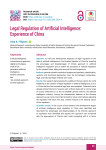
Legal Regulation of Artificial Intelligence: Experience of China
Статья
Objective: to trace the development trajectory of legal regulation in the field of artificial intelligence in the People’s Republic of China by revealing the advantages and disadvantages of China’s approach to artificial intelligence regulation and to outline the prospects of national regulation for the nearest future, taking into account the world experience. Methods: general scientific methods of analysis and synthesis, classification, systemic and functional approaches. Also, the formal-legal, comparative-legal, and historical-legal methods were used. Results: the research demonstrates the validity of Chinese claims for world leadership in the creation of legal regulation of artificial intelligence, as it is in China that the first normative legal acts were adopted. These acts have already entered into force; however, each of them deals with a narrow range of issues, while there is no law to establish general rules for the artificial intelligence industry. Among the characteristic features of the Chinese approach we can name, first of all, its iterative nature, which allows adjusting the regulation with each new step. Another feature is the sectoral nature of the regulation. Scientific novelty: in the course of the research, the development stages of artificial intelligence legal regulation in China were identified and described; the advantages and disadvantages of the Chinese approach to regulation were identified and argued; this approach was compared with the approaches of China’s main rivals competing with it in terms of the technology development and its legal regulation. All of the above allowed making conclusions about the subsequent development of legal regulation in China and in the whole world. Practical significance: familiarization with the research materials enables interested legal scholars, and not only them, to get a clear idea of the level of artificial intelligence regulation, achieved by China. China’s experience is of significant interest to the rest of the world, showing the correctness or faults of possible regulatory options in the new and complex field. The study results can be used in the practice of legal regulation in the sphere of artificial intelligence, as well as in preparing lectures in the relevant courses and writing tutorials for law students.
Бесплатно
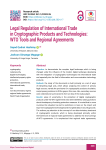
Статья
Objective: to demonstrate the complex legal landscape which is being changed under the influence of the modern digital landscape developing with the integration of cryptographic technologies into international trade and especially into the field of information and communication technology products. Methods: the study of the documents is built primarily on a set of ways of interpreting legal acts, which allows analyzing the content of primary legal sources, namely the provisions for cryptographic products circulation, and proposing solutions to fill the gaps in this area. Also, secondary sources were collected and summarized to form an idea of the study subject. Results: areas of uncertainty in the protection of digital cryptographic products under the WTO agreements have been identified, raising questions about the adequacy of existing protection measures. It is noted that in some countries this situation has led to restrictions or bans on the import and export of cryptographic technologies and encrypted data on security grounds. The authors pay attention to the concept of non-discriminatory treatment of cryptographic products, which is being developed primarily within the framework of regional trade agreements to address the shortcomings of WTO agreements. It is emphasized that regional trade agreements, although stimulating cooperation and competition in international trade, demonstrate various approaches to the regulation of cryptographic products. The authors note that this creates challenges for business and it must be prepared to take into account the specificities of regional agreements, local legislation and evolving legal requirements. A conclusion is made that it is important to balance the innovation protection with the promotion of trust and cooperation, between the cryptographic technologies development and the issues of security and intellectual property rights protection. Scientific novelty: a vision of the complex legal landscape surrounding cryptographic products is presented, showing the differences in approaches to regulating relations around digital and non-digital products under WTO agreements and approaches to regulating cryptographic products applied in regional trade agreements. Practical significance: the study results are of interest to government agencies, policy makers, commercial entities and individuals involved in international trade in cryptographic technologies, as they can help all stakeholders to make informed decisions, navigate the complexities of regulating these relationships and advocate for fair treatment in the evolving digital trade environment.
Бесплатно
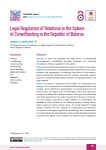
Legal Regulation of Relations in the Sphere of Crowdfunding in the Republic of Belarus
Статья научная
Objective: to study the theoretical and legal bases of crowdfunding and to elaborate scientifically grounded proposals for improving the Republic of Belarus legislation in this sphere. Methods: the methodological basis of the research is a system of principles, methods and techniques of studying the general regularities of emergence, formation and development of social-legal phenomena. In the research, general and specific methods of scientific cognition were used: analysis, synthesis, comparative-legal, logical, systemic, formal-legal, dialectic and other methods. Results: the history of emergence and formation of crowdfunding was analyzed. The social-economic and technical-technological factors were revealed, which facilitate the popularization of crowdfunding among the Internet users. The origins of the “crowdfunding” notion were discussed, as well as its filling with a definite meaning. The types of crowdfunding were listed, depending on the goal of investment on the part of investors. The main subject composition of legal relations in crowdfunding was established, which consists of the following persons: funding seeker; funder; operator of online-funding service. The overall algorithm of legal relations between the main subjects of crowdfunding was described. The positive and negative aspects of crowdfunding were characterized. An overall analysis of foreign legislation in the crowdfunding legal regulation was performed. Based on the analysis, the general trends of legislation development were presented. The program and normative legal acts on developing crowdfunding in the Republic of Belarus were reviewed. The probable contract models of the parties’ legal relations registering were named. The technical and legal requirements to the functional of an online-funding service were determined. The minimal necessary set of measures was proposed, which may prevent risks and threats associated with procurement and extension of funds through online-funding services. Based on the operator functions, specific requirements to the rules of online-funding service were determined. Scientific novelty: the author comprehensively studied the notion, legal nature and features of legal regulation of crowdfunding. The factors were revealed, which influence the formation of the legal norms regulating the procurement and extension of funds through online-funding services. The author elaborated proposals for improving the Republic of Belarus legislation in the sphere of social relations under study. Practical significance: the research results are significant for developing the studies in the sphere of civil, economic, and informational law. The obtained results may be used in teaching a course in civil, economic, and informational law, as well as be applied by law subjects when elaborating and introducing the respective drafts of laws and be an object of further scientific research on the issue.
Бесплатно

Статья
Objective: to determine the level of protection of the rights of content creators in social media and to develop measures to prevent offenses in this area. Methods: to achieve the objective, the sociological and legal cognitive tools were used, including the doctrinal method of researching the subject area, obtaining “first-hand” data and taking into account the factors and circumstances of influence. The main results were obtained through the sociological method used to collect data based on a specially developed questionnaire with four research questions: (1) what are the perceptions and opinions of third parties or users regarding the role of a content creator? (2) are the rights of content creators regarding their works violated? (3) what are the ways to protect the created content from infringement by platforms? and (4) how can the rights of content creators be protected? The empirical findings and generalizations were based on a combination of analyses, including content analysis of primary and secondary legal sources. Results: In recent years, the content generation in social media has evolved into a complex industry that is transforming both the traditional understanding of creative expression and the implementation of intellectual property rights. Using the Nigerian experience as a case study, the authors examine the rights and protection measures provided to digital content creators under intellectual property law. The study shows that there is currently not enough scholarly work in this area or developed legislation to protect the social media content. It is concluded that there is a need for improved legislation on the protection of rights in the sphere of social media content. In the absence of such legislation, creators of online works should resort to more radical methods in enforcing their rights in order to reduce intellectual property misappropriation. Creators of such works are suggested to ensure the protection of their rights based on the fair use doctrine principles. Scientific novelty: the study is structured around research questions concerning infringements and remedies for content creators. The questions were addressed to respondents from different countries, a large proportion of whom specialize mainly in content creation in various social spheres through several media platforms and social networks. Practical significance: the article conclusions and recommendations may minimize the risks of infringement of intellectual property rights of content creators, which may arise with the widespread use of social networks, as well as increase the level of protection of rights to works created in the form of online content.
Бесплатно
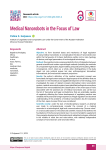
Medical Nanorobots in the Focus of Law
Статья научная
Objective: to form doctrinal bases and mechanics of legal regulation of using medical nanorobots; to conceptualize the idea of nanorobotics law within the frameworks of its basic definitions, safety norms, risks, typology of devices, and legal parameters of technological terminology. Methods: the cognition tools are represented in the form of integration between general scientific and modern special legal methods (including the methods of comparative legal studies, legal modeling and juridical forecasting, NBICS-convergence), which, taken as a whole, allow distinguishing in the study object not only juridical proper, but also anthropological, biomedical, informational, and mechanistic research projections. Results: the author’s definition of the medical nanorobot concept was formulated; the legal content and quasi-legal aspects of the definition that are important for the theoretical and applied development of terminology were investigated; the signs of related concepts (biomedical robot, nanorobotic system, medical nanorobotic system) were identified and logical connections between them were established; the classification of the main types of risks associated with the practical use of medical nanorobots was carried out; the list of theoretical and legal contradictions that are potentially capable of negatively affecting the future development of regulatory practice was revealed; the Russian and foreign experience of legal regulation and doctrinal understanding of the problems of medical nanorobotics (by the examples of the USA, Japan, Europe, China) was considered. Scientific novelty: under the lack of interdisciplinary research, an attempt was made to comprehensively consider the concept of a medical nanorobot in a technological, legal and communicative way (“human robot” on a nanoscale) based on the advanced scientific research that defines the foundations of the future nanorobotic law. It is recommended to supplement the synergetic development of biomedical and related technologies, reflected in the models of robot law and robot ethics, with relatively independent concepts of nanorobot law and nanorobot ethics. Practical significance: based on the analysis of the legal regulation system in force in Russia and abroad, mechanisms for improving domestic legislation were identified, including taking into account the achievements of juridical crowdsourcing. Within the framework of socio-humanitarian issues, a contribution to the development of legal, sociological, and psychological science is formed. A scientific and methodological basis was prepared for further legal research and law-making activities in the field of medical nanorobotics.
Бесплатно
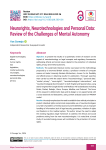
Neurorights, Neurotechnologies and Personal Data: Review of the Challenges of Mental Autonomy
Статья обзорная
Objective: to present the results of a systematic review of research on the impact of neurotechnology on legal concepts and regulatory frameworks, addressing ethical and social issues related to the protection of individual rights, privacy and mental autonomy. Methods: The systematic literature review was based on the methodology proposed by a renowned British scholar, a professor emerita of computer science at Keele University Barbara Kitchenham, chosen for its flexibility and effectiveness in obtaining results for publication. Thorough searches were carried out with the search terms “neurotechnology”, “personal data”, “mental privacy”, “neuro-rights”, “neurotechnological interventions”, and “neurotechnological discrimination” on both English and Spanish sites, using search engines like Google Scholar and Redib as well as databases including Scielo, Dialnet, Redalyc, Lilacs, Scopus, Medline, and Pubmed. The focus of this research is bibliometric data and its design is non-experimental with a cross-sectional and descriptive, using content analysis based on PRISMA model. Results: the study emphasizes the need to establish clear ethical principles to protect individual rights and promote responsible use of neurotechnologies; a number of problems of mental autonomy were identified, such as improper handling of information, lack of legal security guarantees, violation of rights and freedoms in the medical sphere. The author shows the need to adapt the existing regulatory legal framework to address the ethical and social problems arising from the new neurotechnologies. It is noted that a broad study of neurotechnology issues will contribute to the protection of human rights. Scientific novelty: an expanded understanding of the five neurorights within the Universal Declaration of Human Rights is proposed; neurorights are viewed as a new category of rights aimed at protecting mental integrity against the misuse of neurotechnologies. The author justifies the adoption of such technocratic principles as personal identity, free will, mental privacy, equal access and protection against bias. Practical significance: the obtained results are relevant for understanding modern legal concepts related to neurorights and for adapting the existing normative legal acts to solve ethical and social problems arising from the emergence of new technologies, protection of human neurorights and liability for their violation. The study of these issues is key for provision of further responsible development and use of neurotechnologies.
Бесплатно
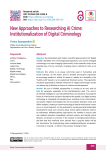
New Approaches to Researching AI Crime: Institutionalization of Digital Criminology
Статья научная
Objective: the article deals with modern scientific approaches to the “digital society”, identifies new criminological perspectives, such as that of digital criminology in an ever-changing hybrid world, in the scientific study of the potential use of AI by criminals, including what is referred to here as AI crime. Methods: this article is an essay commonly used in humanities and social sciences, as the author aims to present provocative arguments to encourage readers to rethink AI issues in relation to criminality in the “hybrid world” based on a non-systematic literature review. The arguments should be supported by relevant references to “digital criminology” and its non-binary way of thinking in favour of a techno-social approach. Results: the era of divided perspectives is coming to an end, and it’s time for synergies, especially at the interdisciplinary level. The «mirror of artificial intelligence» can help identify flaws and solutions, ensuring the future of AI and human society is decided by the people. In a digital society, technology is integrated into people’s lives, including crime, victimization, and justice. Digital technologies blur the boundaries between online and offline realities, creating a human-technological hybrid world where crimes occur in virtual networks. AI has potential for social good and Sustainable Development Goals, but concerns about human rights violations need to be addressed. Multidisciplinary approaches are needed to ensure safe use, address education inequalities, enhance justice, and identify online behavior as deviant or criminal. In the context of emerging technoethics, the idea that this unofficial norm, derived from a popular belief, will be the ‘touchstone’ for characterising online mediated behaviour as deviant/crimninal, is missing - or rather in the process of being formed. Scientific novelty: the author aims to provide some insightful thoughts on formulating the right questions and interesting reflections from a technoethical perspective on the phenomenon of the use of information and communication technologies for criminal purposes under the catalytic influence of AI, recognising the social challenges arising from technological disruption (e.g. prediction and prevention through the transformation of policing, increased surveillance and criminal justice practises) in “digital society”. Practical significance: some of the initial ideas of this theoretical material can be used in the elaboration of proposals for amendements and additions to the current crime legislation, as well as in pedagogical activity, especially in the implementation of educational courses or modules on crime in the context of the digital transformation of society.
Бесплатно
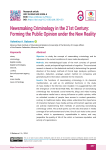
Newsmaking Criminology in the 21st Century: Forming the Public Opinion under the New Reality
Статья научная
Objective: to study the concept of newsmaking criminology and its relevance in the current conditions of mass media development. Methods: the methodological basis of the work consists of general scientific, social, and special-legal methods of cognition. The conducted research is based on the dialectical method (in determining the general direction of the study), methods of formal logic (analysis, synthesis, induction, deduction, analogy), system method (in comparing and generalizing the information collected for the research). Results: the functions of newsmaking criminology in its classical manifestation, as well as its additional functions in the study of mass media in the Internet, were revealed. It is suggested that with the emergence of the World Wide Web, the relevance of newsmaking criminology has increased: social networks, blogs and video hosting as alternative media have a strong influence on public opinion, while an unlimited number of people have access to content generation, contrary to traditional media. Many states understand the importance of interaction between mass media and law enforcement agencies and are actively implementing their methods of promoting newsmaking criminology online. This article points out the risks that arise in media coverage of law enforcement and crime. One of such risks is the cancel culture, which is spontaneous, unpredictable in nature, and may jeopardize the quality of life of the victim or business reputation and activity of organizations. Scientific novelty: the functions performed by newsmaking criminology in the study of traditional and alternative media were identified. So far, such doctrine has not been sufficiently researched taking into account modern forms of mass communication. Examples of interaction between law enforcement agencies of different states and the media were analyzed. Practical significance: the study contributes to understanding the correlation between criminological phenomena and modern media platforms. The Internet and social networks provide new channels of information exchange that differ significantly from traditional media such as printed media or television.
Бесплатно
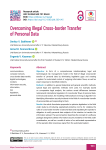
Overcoming Illegal Cross-border Transfer of Personal Data
Статья
Objective: to form of a comprehensive interdisciplinary legal and technological risk management model in the field of illegal cross-border transfer of personal data by eliminating legislative gaps and creating a system for automated control of outgoing information flows, as well as expert response to identified incidents. Methods: in addition to general dialectical and general scientific methods, special legal and cybernetic methods were used. For example, based on comparative legal analysis, the authors reveal differences between national and international regulation of cross-border flows of personal data. In the second section, the modeling method allows forming an algorithm for identifying information security incidents in the field of cross-border transfer of personal data and responding to them. Results: the article formulates proposals to optimize legislation in the field under study by introducing specialized protective norms for violating the rules of cross-border transfer of personal data and stipulating the operator’s obligation to notify personal data subjects of the intention to transfer the information abroad. The second section describes the concept of a software package designed to detect information security incidents in the field under consideration, as well as a model of action of an authorized representative of the operator after receiving a signal from the automated system. Scientific novelty: to solve the set problem, the work combines the knowledge and competencies of legal scientists and specialists in the field of information security, which allows an interdisciplinary approach. At the same time, it is stated that the issues of illegal cross-border transfer of personal data have not received proper coverage in science today, since Russian legislation in this area has changed recently. The authors propose not so much to strengthen the sanction for legislation violation in this area, as to ensure the punishment of persons who commit cyberattacks, and to equip personal data operators with an effective tool to minimize the risks of information leakage. Practical significance: the research results can be used to improve legislation in the field of cross-border transfer of personal data and the organization of activities of authorized employees of the personal data operator for risk management in this area.
Бесплатно
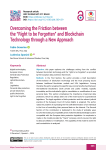
Статья научная
Objective: this paper explores the challenges arising from the conflict between blockchain technology and the “right to be forgotten” as provided by the European data protection framework. Methods: in the First Section, the author provides a brief description of the evolution of blockchain technology and the most pressing issues between traditional blockchain models and UE’s legislations. Among the latter, the author analyzes the specific issue concerning the clash between the traditional blockchains (both private and public models), typically immutable, and the individual’s right to cancellation or modification of own personal data. This section emphasizes the importance of personal data protection, which has always been one of the main tasks for supranational legislators. The legal regulation of data protection and the relevant judicial practice of the European Court of Human Rights is analyzed. The author raises the problem of expressing the free self-determination of an individual in the form of controlling their personal data on the Internet. The Second Section of this contribution is dedicated to the study of probable ways to solve the existing incompatibility and to make the distributed ledger system compatible with the European data protection legislation. An emphasis is made on the model provided by “Traent” company, which ensures the right to data cancellation or modification. The capability of this model to solve the said contradiction is analyzed. Results: the study delves into the peculiar features of the new model to understand how it strategically utilizes the advantages of public and private blockchains guaranteeing not only the validity and authenticity of the chain where the transaction was performed, but, most importantly, the modification and granular cancellation of client’s personal data. This innovative solution offers a potential path forward for navigating the complex intersection of data privacy and blockchain innovation in the European context. Scientific novelty: Traent has implemented a “hybrid” model blockchain that, incorporating both public and private components, to achieve an effective compliance with the European Union regulations, especially those concerning data protection and privacy. Practical significance: the obtained conclusions and proposals can be taken into consideration in improving the compliance of blockchain technologies with the European Union General Data Protection Regulation.
Бесплатно
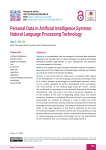
Personal Data in Artificial Intelligence Systems: Natural Language Processing Technology
Статья
Objective: to conceptualize, from the viewpoint of personal data protection legislation, the development of natural language processing technology, identifying possible legal barriers to such development and directions for further research of the issue. Methods: the research is based on general scientific methods of cognition, along with which formal-legal and comparative-legal methods were applied, as well as the method of theoretical modeling. Results: it was found that the observance of personal data regime in the development of natural language processing technology leads to a conflict between private-legal and public-legal interests, which, in turn, creates obstacles for further development of this technology. The shortcomings of the existing legal order are shown, namely, the insufficient correspondence to the technical features of technology development. This may lead to the risks of excessive regulation, or, on the contrary, to the risks of neglecting critical areas that require protection. Problems in qualifying the data involved in the technology development are outlined. An attempt is made to define the limits of ensuring the lawfulness of personal data processing within the natural language processing technology. The material, temporal and territorial effect of the legal regulation in this field is identified as the limits of ensuring the legality. The author touches upon the possibility of using personal data as a consideration, which is important for the development of natural language processing technology and for the improvement of the information and communication technology industry. Scientific novelty: the paper supplements the scientific discussion on the legal regulation of personal data processing by artificial intelligence systems with an analysis of natural language processing technology. The latter is insufficiently studied, making it relevant to research information law, namely, the legal relations arising around artificial intelligence systems, and to assess the impact of a personal data regime on the development of natural language processing technology. Practical relevance: the applied aspects of the problems researched and the results obtained can be used to improve the legal regulation of public relations in the field of creation and development of artificial intelligence, as well as to identify and assess the legal risks arising in the personal data processing by developers of digital products based on natural language processing technology.
Бесплатно
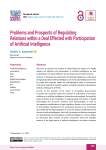
Статья научная
Objective: to research the problem of determining the subject of a legally relevant act effected with participation of artificial intelligence, as well as distribution of responsibility for the consequences of its performance. Methods: to illustrate the problematic and practical significance of the issue of legal personality of artificial intelligence, we chose automated procurements for public and corporate needs; the methodological basis of the research is the set of methods of scientific cognition, including comparison, retrospective analysis, analogy, and synthesis. Results: by the example of the sector of competitive procurements for public and corporate needs, the evolution of automation of economic relations up to artificial intelligence introduction was analyzed. Successfully tested reactions to the challenges of stage-by-stage introduction of digital technologies into economic relations were demonstrated, as well as the respective modifications of legal regulation. Based on the current level of technological development, the prospective questions are formulated, associated with the legal regulation of economic relations implemented with the use of artificial intelligence, first of all, the question of defining the subject of a deal effected with participation of artificial intelligence. As an invitation for discussion after analysis of jurists’ conclusions about the probable variants of the legal status of artificial intelligence, the author proposes variants of answers to the question of its legal personality when effecting a deal. To solve the issue of responsibility for the decisions resulting from the implementation of algorithms of a software and hardware package, we propose several models of distributing such responsibility among its creator, owner, and other persons, whose actions might influence the results of such an algorithm functioning. The proposed conclusions may be used to develop normative regulation both as a set and individually. Scientific novelty: based on the analysis of evolution of the practices of using digital technologies in procurement, the work formulates potential legal problems, determined by the constant automation of economic relations, and proposes legal constructs to solve such problems. Practical significance: the conclusions and proposals of this work are of prospective significance for conceptual comprehension and normative regulation of electronic procurement tools both at corporate and national level.
Бесплатно
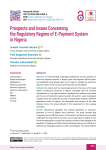
Prospects and Issues Concerning the Regulatory Regime of E-Payment System in Nigeria
Статья
Objective: to reveal the legal challenges impeding the smooth operation of electronic payment systems in Nigeria, given that Nigerian official bodies and individuals have already taken some steps to regulate the electronic payment system in the country, but the said step are insufficient. Methods: the study is built on several approaches to the issues of the legal regime of electronic payments in Nigeria. Alongside with the doctrinal interpretation of the legal framework regulating the relations associated with the use of electronic payment system, the authors used sociological cognitive tools and conducted a survey of respondents residing in different geopolitical zones of Nigeria. The description and analysis of the data obtained shows the actual attitude of the respondents to the ongoing processes. Results: international regulation and national legislation on electronic payments in force in Nigeria were examined. The study revealed that e-payments are an effective means of transactions but there are some legal challenges that may hinder the smooth use of e-payments in Nigeria. It was found that although the country has enacted a number of laws relating to the regulation of banking and other financial activities, they are not sufficient to address the challenges posed by modern technologies. The article reflects the issues of electronic signature, trust in technology, data privacy, security of electronic transactions, fraud, authentication and authorization, certainty of rights and obligations, jurisdiction and platforms for resolving online disputes, taxation of electronic payments, and others. The authors note that the task of creating a secure digital environment for the smooth operation of e-commerce and e-payments in Nigeria should not be solely imposed on the government. Scientific novelty: by the example of one of the most promising African states, the authors revealed a spectrum of issues related to the work of electronic payment systems, supporting it with a survey of public opinion. They managed to find out the citizens’ attitude to a number of issues that are most often faced when using the system of electronic payments, and possible areas of change. Practical significance: the current legal issues raised in the study largely hinder the smooth use of the electronic payment system in Nigeria. Hence, the possible ways to improve it suggested by the authors are increasingly significant.
Бесплатно
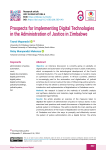
Prospects for Implementing Digital Technologies in the Administration of Justice in Zimbabwe
Статья
Objective: an intensive discussion is currently going on globally on digitalization and automation of providing services in public institutions, which corresponds to the technological development of the Fourth Industrial Revolution. The use of digital technologies is crucial to create an optimized service delivery system. In African countries, attention is increasingly paid to the automation and digitalization of judicial activities, due to concerns about the risks of influencing justice systems. In light of this, the article is aimed at forming a promising model for the introduction and implementation of digitalization in Zimbabwe courts. Methods: the research is based on the methods of scientific analysis and synthesis, deduction and induction, legal modeling, formal legal and comparative legal methods. Results: the article provides an overview of the measures taken to digitalize the system of administration of justice in various states. It also examines best practices and reveals the essence of digitalization in the judicial system in Zimbabwe. The authors identify the main existing and promising directions of the impact of digitalization on the judicial system of Zimbabwe and show the ways to promptly and effectively convert the system of justice administration into a digital format. The article identifies the advantages of digital data processing in judicial bodies and obstacles to the use of digital systems in the administration of justice. The latter result in the insufficient optimality of the Integrated Electronic Case Management System (IECMS). Scientific novelty: the study builds an optimal model for the introduction of digital technologies into the judicial system in Zimbabwe, aimed at improving the efficiency of courts digitalization and transforming the justice administration system. The authors proved that the crucial factors of achieving this goal are the auxiliary infrastructure of information and communication technologies, the level of education and awareness of citizens, and the ongoing state and legal policy. Practical significance: it is expected that the proposed model to implement digitalization in Zimbabwe courts and improve its efficiency will allow for the comprehensive and uninterrupted implementation of IECMS.
Бесплатно
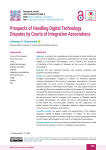
Prospects of Handling Digital Technology Disputes by Courts of Integration Associations
Статья научная
Objective: to analyze the competence and procedure of case handling by the courts of integration associations, allowing them to resolve disputes related to information technologies, and to identify the prospects of handling of this category of disputes by the courts of integration associations. Methods: the main research methods were analysis, synthesis, and problem-theoretical method. Results: the article identified the main features of the “disputes related to digital technologies” category in relation to resolving disputes involving individuals by the courts of integration associations. It reveals opportunities for some courts of integration associations to resolve disputes related to information technologies. The said opportunities are provided by the courts competence, allowing the appeal of individuals, as well as by the dispute resolution procedure involving experts. By analyzing international treaties and practice of courts of integration associations, the author proves that the changes in the category of “disputes related to digital technologies” are related not only to technologies, but also to information and communication systems. By own judgments, the author reveals the content of disputes related to digital technologies in the courts of integration associations. Scientific novelty: the paper reveals the peculiarities of the category “disputes related to digital technologies” in relation to the courts of integration associations and the prospects of resolving disputes related to information technologies by the courts of integration associations. Practical significance: the conclusions provided in the article can be used to improve the practice of courts of integration associations.
Бесплатно
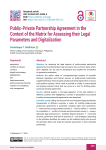
Статья
Objective: by reviewing the legal aspects of public-private partnership agreements, to synthesize their main provisions into a common matrix, which, when digitized, can be used to standardize and simplify the formulation of agreement parameters. Methods: the author relied on comparative-legal analysis of scientific literature, legislation and Internet sources on public-private partnership, supplemented by a review of public-private partnership agreements in various socio-political spheres, which made it possible to create a science-based and practice-oriented matrix that can serve as a tool for drafting public-private partnership agreements. Results: national aspects in the legal regulation of the said relations in different countries were highlighted; a number of peculiarities encountered in public-private partnership agreements were described. Scientific novelty: taking into account the most important legal peculiarities characteristic of different countries, a matrix for drafting public-private partnership agreements is presented, including eight main parameters: 1 – value received, scope, benefits and risks, 2 – route to market, 3 – restraint of competition, 4 – conflict of interest and procurement issues, 5 – powers, approvals, legal assessment, 6 – liabilities, dispute resolution, 7 – ownership structure, governance and level of autonomy, 8 – exit strategies. Depending on the priorities identified, the matrix can be modified, taking into account that priorities define and shape the specific parameters of each individual partnership. Practical significance: the matrix obtained can become a planning tool used to analyze and understand the relationships between the eight legal parameters necessary for the formation of relations in the sphere of public-private partnership. It may serve as a legal reference point for the formulation of public-private partnership agreements around the world, and will contribute not only to the revitalization of public-private partnerships, but also to a proper understanding of obligations, responsibilities and limitations. The recommendations provided in the study show direction for the evaluation of public-private partnerships, allowing clear conclusions to be drawn about the partnership. Digital accessibility provided, the proposed matrix will be of interest to many organizations that use public-private partnerships in their professional activities.
Бесплатно

Статья научная
Objective: to formulate the bases for quantum law as the law of the future, based on the study of quantum phenomena and features of quantum technologies determining the risks and challenges associated with the emergence of these technologies, as well as the analysis of legal regulation of quantum technologies in the Russian Federation and abroad. Methods: to carry out this research, the authors applied a complex of general scientific methods of systemic analysis and specific methods of engineering and legal sciences. The use of comparative-legal method allowed revealing the main directions of developing legal regulation of quantum technologies in the Russian and foreign law orders based on the analysis of their international and national regulation. The method of legal modeling allowed forming a concept of quantum law, revealing the main vectors of its development and the complex of its ethical-legal principles. Results: the features and properties of quantum technologies were revealed which can change the development of law with the advent of these technologies; the main risks and challenges were identified which are associated with the development of quantum technologies; the features of quantum technologies regulation in some foreign countries were specified; the trends of developing the quantum technologies regulation in the Russian Federation were identified; the conceptual bases of quantum law were formulated, as well as the vectors of its development. Scientific novelty: for the first time in the legal science, a complex analysis of the current national (both Russian and foreign) regulation of quantum technologies was carried out, based on which an attempt was made to substantiate the need to form quantum law and to outline the main vectors of its development. Practical significance: the research results lay the foundation for forming the concept of quantum law; in this regard, the authors’ conclusions and proposals for improving the current regulation of quantum technologies can be used in law-making and law enforcement in this sphere, and may lay the bases for further research in the sphere of quantum technologies.
Бесплатно

